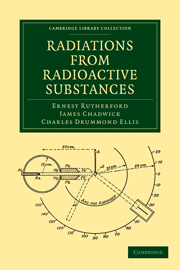Book contents
- Frontmatter
- Contents
- LIST OF PLATES
- Preface
- Chap. I Radioactive Transformations
- Chap. II The α Rays
- Chap. III Absorption of the α Rays
- Chap. IV Some Properties of the α Particle
- Chap. V Theories of Absorption of α Rays
- Chap. VI Secondary Effects produced by α Rays
- Chap. VII General Properties of the Radiations
- Chap. VIII The Scattering of α and β Particles
- Chap. IX The Collisions of α Particles with Light Atoms
- Chap. X The Artificial Disintegration of the Light Elements
- Chap. XI The Radioactive Nuclei
- Chap. XII β Ray and γ Ray Spectra
- Chap. XIII The Disintegration Electrons
- Chap. XIV The Passage of β Particles through Matter
- Chap. XV The Scattering and Absorption of γ Rays
- Chap. XVI Intensity Problems connected with the Emission of γ Rays
- Chap. XVII Atomic Nuclei
- Chap. XVIII Miscellaneous
- Appendix
- Subject Index
- Index of Names
- Plate section
Chap. II - The α Rays
Published online by Cambridge University Press: 07 September 2010
- Frontmatter
- Contents
- LIST OF PLATES
- Preface
- Chap. I Radioactive Transformations
- Chap. II The α Rays
- Chap. III Absorption of the α Rays
- Chap. IV Some Properties of the α Particle
- Chap. V Theories of Absorption of α Rays
- Chap. VI Secondary Effects produced by α Rays
- Chap. VII General Properties of the Radiations
- Chap. VIII The Scattering of α and β Particles
- Chap. IX The Collisions of α Particles with Light Atoms
- Chap. X The Artificial Disintegration of the Light Elements
- Chap. XI The Radioactive Nuclei
- Chap. XII β Ray and γ Ray Spectra
- Chap. XIII The Disintegration Electrons
- Chap. XIV The Passage of β Particles through Matter
- Chap. XV The Scattering and Absorption of γ Rays
- Chap. XVI Intensity Problems connected with the Emission of γ Rays
- Chap. XVII Atomic Nuclei
- Chap. XVIII Miscellaneous
- Appendix
- Subject Index
- Index of Names
- Plate section
Summary
§ 10a. Comparison of the radiations. All the radioactive substances possess in common the power of acting on a photographic plate and of ionising the gas in their immediate neighbourhood. The intensity of the radiations may be compared by means of their photographic or electrical action, and in the case of the strongly radioactive substances by the luminosity excited in a phosphorescent screen.
Two general methods have been used to distinguish the types of radiation given out by a radioactive matter depending upon
(1) a comparison of the relative absorption of the rays by solids and gases,
(2) observations on the direction and magnitude of the deflection of the rays when exposed to the action of strong magnetic and electric fields.
Examined in this way, it has been found that there are three distinct primary types of radiation emitted from radioactive bodies which for brevity and convenience have been termed the α (alpha), β (beta), γ (gamma) rays.
(1) The a rays, which are very readily absorbed by thin metal foil or by a few centimetres of air, consist of a stream of positively charged atoms of helium, initially projected from the radioactive matter with high velocity, which varies for different substances between 1·4 × 109 and 2·2 × 109 cm./sec. Normally the α particle at the moment of its expulsion carries two positive charges and is to be identified with the nucleus of the helium atom.
[…]
- Type
- Chapter
- Information
- Radiations from Radioactive Substances , pp. 38 - 66Publisher: Cambridge University PressPrint publication year: 2010First published in: 1930



